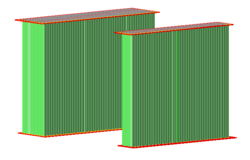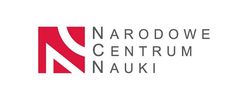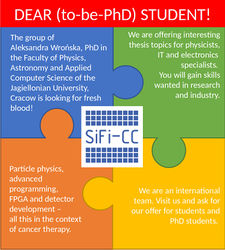Main Page
SiFi-CC: ON-LINE MONITORING OF DOSE DISTRIBUTION IN PROTON THERAPY USING HEAVY SCINTILLATING FIBERS
Context
The project SiFi-CC is a joint effort of a group of researchers and students from the Jagiellonian University in Kraków, Poland, RWTH Aachen University, Germany and the University of Lübeck, Germany. The aim of the project is the development of a method for on-line monitoring of a cancer treatment called proton therapy. In this kind of treatment, a tumour is irradiated with a proton beam with parameters adjusted such, that protons deposit maximum of their energy in the tumour region, leading to the destruction of tumour cells. For this purpose, a treatment plan is prepared individually for each patient, usually based on CT (computed tomography) or PET (positron emission tomography) images. However, human body undergoes changes, which may lead to misplacement of the applied dose compared to the original plan. Therefore methods for on-line monitoring in proton therapy are sought for, as they would allow preparing better treatment plans for patients, leading to better and safer treatment.
Project
Job offers
Collaboration
The project SiFi-CC is a joint effort of the group:

|

|

|

|

|

|

|

|
| Aleksandra Wrońska1 |
Ronja Hetzel6, formerly 2 |
Magdalena Rafecas5 |
Jorge Roser5 |
Katarzyna Rusiecka1 |
Achim Stahl2 |
Mark Wong1 |
Vitalii Urbanevych1 |
| PI, professor | post-doc | professor | post-doc | post-doc | professor | post-doc | post-doc |

|

|

|

|

|

|

| |
| Magdalena Kołodziej1 |
Monika Kercz1 |
Gabriel Ostrzołek1 | Philippe Clement1, formerly 2 | Mikołaj Dubiel1 | Szymon Machura1 | Dominik Szubartowski1 | |
| PhD student | PhD student | PhD student | PhD student | Master student | Master student | Master student |
Former members, also those working on the gCCB project:
Awal Awal2, Piotr Bednarczyk3, Anna Bekas1, Andreas Bolke5, Daniel Böckenhoff2, Arshiya Anees Ahmed1, Arkadiusz Bubak4, Richard Chomjak1, Michelle Dombeu2, George Farah2 Sabine Feyen2, Grzegorz Gazdowicz1, Aleksandra Kaszlikowska1, Majid Kazemi Kozani1, Laurent Kelleter2, Jonas Kasper2, Nadia Kohlhase5, Barbara Kołodziej1, Adam Konefał4, Wojciech Kozyra1, Karim Laihem2, Rafał Lalik1, Johannes Leidner2, Andrzej Magiera1, Sara Müller2, Grzegorz Obrzud1, Marek Pałka1, Mareike Profe2, Damian Stachura1, Szymon Świstun1, Aneta Wiśniewska1, Anna Władyszewska1, Mirosław Ziębliński3 Alexander Fenger2 Linn Mielke2
1Institute of Physics, Jagiellonian University, Kraków 2III. Physikalisches Institut B, RWTH Aachen University, Aachen 3Institute of Nuclear Physics PAN, Kraków 4University of Silesia, Katowice 5Institute of Medical Engineering, University of Lübeck 6Biophysics Department, GSI Helmholtzzentrum für Schwerionenforschung GmbH, Darmstadt
Publications
2025
B. Kłębowski, B. Kołodziej, B. Beus, M. Garbacz, R. Hetzel, J. Kasper, A. Kaszlikowska, A. Magiera, A. Wrońska
Bragg peak position monitoring using silicon and titanium nanoparticles as prompt-gamma tracers
Physica Medica 137 (2025) 105068 doi:10.1016/j.ejmp.2025.105068 pdf
J. Kasper, A. Awal, R. Hetzel, M. Kołodziej, K. Rusiecka, A. Stahl, M.-L. Wong and A. Wrońska
Genetic algorithm as a tool for detection setup optimisation: SiFi-CC case study
Physics in Medicine and Biology, (2025) pdf arXiv,doi:10.1088/1361-6560/adec39
submitted on 27.08.2024, resubmitted v2 on 23.03.2025, resubmitted v3 30.06.2025, accepted 2.07.2025
M. Kołodziej, S. Brons, M. Dubiel, G. N. Farah, A. Fenger, R. Hetzel, J. Kasper, M. Kercz, B. Kołodziej, L. Mielke, G. Ostrzołek, M. Rafecas, J. Roser, K. Rusiecka, A. Stahl,
V. Urbanevych, M.-L. Wong, A. Wrońska
First experimental test of a coded-mask gamma camera for proton therapy monitoring
Physics in Medicine and Biology 70 (2025) 115017 doi:10.1088/1361-6560/adc96b preprint-pdf arXiv
2024
J. Roser, R. Hetzel, P. Clement, A. Fenger, J. Kasper, M. Kercz, M. Kołodziej, L. Mielke, K. Rusiecka, A. Stahl, A. Wrońska and M. Rafecas
Range monitoring capabilities with the SiFi-CC Compton camera: spectral-spatial imaging with Monte Carlo-simulated data
contribution to proceedings of 5th Jagiellonian Symposium on Advances in Particle Physics and Medicine, Kraków
Acta Physica Polonica B Proceedings Supplement 17 (2024) 7-A9 doi:10.5506/APhysPolBSupp.17.7-A9 pdf
M. L. Wong, M. Kołodziej, K. Briggl, R. Hetzel, G. Korcyl, R. Lalik, A. Malige, A. Magiera, G. Ostrzołek, K. Rusiecka, A. Stahl, V. Urbanevych, M. Wiebusch and A. Wrońska
Comparison of readout systems for high-rate silicon photomultiplier applications
Journal of Instrumentation 19 (2024) P01019, doi:10.1088/1748-0221/19/01/P01019 pdf arXiv
2023
Ronja Hetzel, Vitalii Urbanevych, Andreas Bolke, Jonas Kasper, Monika Kercz, Magdalena Kołodziej, Andrzej Magiera, Florian Mueller, Sara Müller, Magdalena Rafecas, Katarzyna Rusiecka, David Schug, Volkmar Schulz, Achim Stahl, Bjoern Weissler, Ming-Liang Wong, Aleksandra Wrońska
Near-field coded-mask technique and its potential for proton therapy monitoring
Physics in Medicine and Biology, 68 (2023) 245028, doi:10.1088/1361-6560/ad05b2 pdf arXiv
2022
M. Kazemi Kozani, A. Magiera
Machine learning-based event recognition in SiFi Compton camera imaging for proton therapy monitoring
Physics in Medicine and Biology 67 (2022), 155012 doi:10.1088/1361-6560/ac71f2 pdf
2021
K. Rusiecka, R. Hetzel, J. Kasper, M. Kazemi Kozani, N. Kohlhase, M. Kołodziej R. Lalik, A. Magiera, W. Migdał, M. Rafecas, A. Stahl, V. Urbanevych, M. L. Wong, A. Wrońska
A systematic study of LYSO:Ce, LuAG:Ce and GAGG:Ce scintillating fibers properties
Journal of Instrumentation 16 (2021) P11006, doi: 10.1088/1748-0221/16/11/P11006
A. Wrońska, J. Kasper, A. A. Ahmed, A. Andres, P. Bednarczyk, G. Gazdowicz, K. Herweg, R. Hetzel, A. Konefał, P. Kulessa, A. Magiera, K. Rusiecka, D. Stachura, A. Stahl, M. Ziębliński
Prompt-gamma emission in GEANT4 revisited and confronted with experiment
Physica Medica 88 (2021) 250-261, doi: 10.1016/j.ejmp.2021.07.018,
pdf
M. Kazemi Kozani and A. Magiera on behalf of the SiFi-CC group
In: Proceedings of the NSS MIC 2021
Machine Learning-based Event Recognition in Compton Camera Imaging for Proton Therapy Monitoring
IEEE Transactions on Nuclear Science, pdf, doi???
A. Wrońska, D. Dauvergne
Range verification by means of prompt-gamma detection in particle therapy
chapter in the book Radiation Detection Systems, CRC Press/Routledge, www preprint in HAL
2020
A. Wrońska for the SiFi-CC collaboration
White Book, report on status of research and infrastructure of nuclear physics in Poland, prepared as the proceedings of the conference Przyszłość fizyki jądrowej niskich energii w Polsce a rozwój krajowej infrastruktury badawczej, held in Warsaw in Jan 2019
White Book, ISBN: 978-83-959188-0-3, published Oct 2020
J. Kasper, K. Rusiecka, R. Hetzel, M. Kazemi Kozani, R. Lalik, A. Magiera, A. Stahl, A. Wrońska
The SiFi-CC project – Feasibility study of a scintillation-fiber-based Compton camera for proton therapy monitoring
Physica Medica 76 (2020) 317-325, doi:10.1016/j.ejmp.2020.07.013,
pdf
A. Wrońska for the SiFi-CC group
Prompt gamma imaging in proton therapy - status, challenges and developments
Journal of Physics: Conference Series 1561 (2020) 012021, doi:10.1088/1742-6596/1561/1/012021 pdf
A. Wrońska, R. Hetzel, J. Kasper, R. Lalik, A. Magiera, K. Rusiecka, A. Stahl
Characterisation of components of a scintillation-fiber-based Compton camera
contribution to proceedings of 3rd Jagiellonian Symposium.... in Kraków,
Acta Physica Polonica B, vol. 51 no. 1 (2020) p. 17-25. DOI:10.5506/APhysPolB.51.17
2019
Arshiya A. Ahmed, A. Wrońska, A. Magiera, M. Bartyzel, J.W. Mietelski, R. Misiak, B. Wąs
Reexamination of proton-induced reactions on natMo at 19–26 MeV and study of target yield of resultant radionuclides
Acta Physica Polonica B, vol. 50 (2019) p. 1583, DOI:10.5506/APhysPolB.50.1583
K. Rusiecka et al.
Investigation of the Properties of the Heavy Scintillating Fibers for Their Potential Use in Hadron Therapy Monitoring
chapter in Engineering of Scintillation Materials and Radiation Technologies - Selected Articles of ISMART2018, ISBN 978-3-030-21970-3, Springer Proceedings in Physics 227, pp 195-210
DOI: 10.1007/978-3-030-21970-3_14
A. Wrońska, A. Ruciński
Wyzwania w terapii protonowej – jak leczyć nowotwory lepiej?
Nowoczesne technologie XXI w. – przegląd, trendy i badania. Tom 1, Wydawnictwo Naukowe TYGIEL sp. z o.o., 2019, ISBN: 978-83-65932-70-9, pdf
2018
K. Rusiecka et al.
Shape of the spectral line and gamma angular distribution of the 12C(p,p'gamma4.44)12C reaction
Acta Physica Polonica B 49 (2018) 1637-1652
full text
2017
A. Wrońska et al., Experimental verification of key cross sections for prompt-gamma imaging in proton therapy
Presented at the 2nd Jagiellonian Symposium on Fundamental and Applied Subatomic Physics, Kraków, Poland, June 3–11, 2017
Acta Phys. Pol.B 48 (2017) 1631.
DOI:10.5506/APhysPolB.48.1631
A.Chrobak et al., Comparison of various models of Monte Carlo GEANT 4 code in simulations of prompt gamma production
Zakopane Conference on Nuclear Physics Extremes of the Nuclear Landscape
Acta Phys. Pol.B 48 (2017) 675. full text
L. Kelleter et al. Spectroscopic study of prompt-gamma emission for range verification in proton therapy
Physica Medica 34 (2017) 7-17
DOI:10.1016/j.ejmp.2017.01.003
Submitted version: pdf
2016
A. Wrońska, Gamma Emission in Hadron Therapy - Towards New Tools of Quality Assurance
contribution to conference proceedings pdf
Nuclear Science Symposium and Medical Imaging Conference (NSS/MIC) 2015 IEEE, 2016, DOI:10.1109/NSSMIC.2015.7582186
K. Rusiecka et al., Determination of Gamma Angular Distribution from the Shape of Spectral Line for the First Excited State of Carbon Nucleus
World Journal of Nuclear Science and Technology 6 (2016) 63-70.
full text
2015
A. Wrońska et al., Gamma Emission in Hadron Therapy — Experimental Approach
Contribution to the Proceedings of Zakopane Conference on Nuclear Physics Extremes of the Nuclear Landscape
Acta Phys. Pol. B 46 (2015) 753. full text




